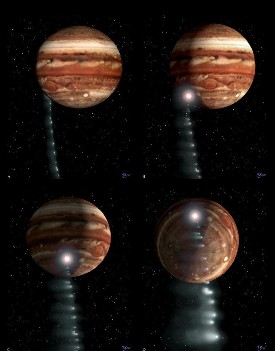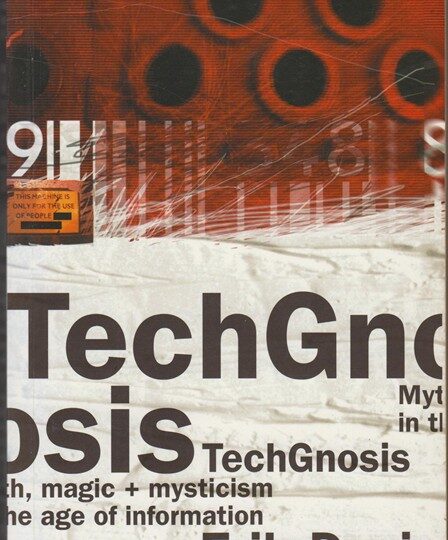
One Small Step for a Man, One Giant Explosion for Comet Shoemaker-Levy 9
The first chunk of comet Shoemaker-Levy 9’s 21 fragments plunged into Jupiter’s swirling gaseous soup at 37 miles per second, producing a fireball half as wide as Earth and spurting a plume of gunk 700 miles above the planet’s top cloud layer, on July 16, 1994. A quarter century to the day before this 225,000 megaton blast, three men in glittery suits sat atop a 36-story tube filled with tons of flaming propellant and headed for the first walk on the moon. Point out the coincidence to desperate NASA officials, and they’ll gush about getting enthused about space again. Point it out to astronomers drooling over photos of Jove, and they’ll probably look at you with impatience, smug apathy, or fear that you will go on to discuss ancient astronauts and ESP. But for those of us who must make our meanings in a webbed world of pop science and pop culture, such a ’60s-’90s conjunction is nothing less than a sign of the times. Twenty-five years ago, America took a crazed and awesome leap that set man (and television) on an alien orb; today, all we can do is sit back and watch as a solar system we like to think of as stable hosts a series of collisions that would pulverize continents on earth.
This week — especially on Wednesday, July 20 when the biggest chunks slam into Jupiter — scientists are looking at the solar system as a colossal, cataclysmic petri dish. But space was a frontier to conquer on July 20, 1969, when my mom dragged a barely two-year-old me out of bed and propped him in front of a TV, hoping to somehow etch the spectral awe of Armstrong’s one small step permanently into my hippocampus. Over half a billion earthlings watched Apollo 11 that night, and in Missions to the Moon, a PBS documentary rebroadcast this Wednesday, Walter Cronkite points out that the live pictures and sound were just as much a miracle as the landing itself. Not only can that ghostly, almost cartoon footage still blow the mind, but it was so impressive, so perfectly crackly, that it spawned a small conspiracy cult that continues to claim that the moonlanding was fake. More riveting even than the trip sequence in 2001: A Space Odyssey, the lunar landing was the crowning spectacle of a spectacular decade, at once transcendent and so thoroughly woven into the tapestry of recorded history that Apollo 11 takes on the decade’s whole hazy Day-Glo aura of political hallucination.
And no wonder: The cannon that shot Apollo 11 into the velvet void was fueled with a demonic fear of the Soviets. The space race restaged the arms race in the empyrean, where the competition could become at once purely symbolic and the supreme test of military-industrial skill. Even the job descriptions of these jarheads were chauvinist—”astronauts” and “cosmonauts,” two sides of the same paranoid coin. And from the beginning, NASA was trapped beneath the dominos, as the Soviets knocked off first satellite, first man in space, first earth orbit, first space walk. But it was Kennedy’s impetuous science-fiction PR that really put the most pressure on, when he promised to put an American on the moon by the end of the decade.
There’s some priceless shots of NASA’s first astroboys in TBS’ recent Moon Shot documentary: buzz-cut and bronzed on Cocoa Beach, corn-fed and shy before reporters, swapping the shit with JFK. These guys were Davy Crockett test pilots, cocky top guns who gladly war the mantle of what Tom Wolfe called the “Cold Warrior of the Heavens.” And while the cast changed, it was these Mercury Seven that set NASA’s archetype. Apollo 11 was a kind of time capsule, the crew’s reticent jaws and crew-cuts and farmboy bravado sustaining an ideal that was, on the planet’s surface, devolving into the steely grimaces of Mayor Daley’s cops and the napalm droppers in Nam.
These flyboys were the patriarchal military-industrial machine’s best and brightest, and it’s impossible not to admire the cool spunk of Neil Armstrong and Buzz Aldrin (what names!) as they manually set the Eagle down on desolate, alien soil with less than 30 seconds of fuel left, their computers overloaded and moondust in their eyes. Apollo 11 was the Man’s Woodstock, the moonwalk his mind-melting “Star-Spangled Banner.” Even the hippies had to go “Wow,” recognizing the moonwalk as a galactic mutation in human experience, the first baby steps of the Age of Aquarius. Along with Apollo 8’s achingly beautiful shots of earthrise over the lunar horizon, the moonwalk was spectacle as consciousness expansion. It’s no accident that astronaut Edgar Mitchell experimented with telepathy on Apollo 14.
Only the hardass political freaks choked on the poetry of it all, bitching about wasted dollars and macho show-off. Soon their ranks would swell. Moon buggies and bunny hops and golf swings did not cut it during the morass of the early ’70s, a time when no one was winning—not the radicals, not the Pentagon, not the space program. The giant step was a dead-end in disguise, and NASA only became good TV when the system crashed. The ominously numbered Apollo 13, which launched in April 1970 at the ominous hour of 13:13 Houston time, had just completed a live TV broadcast (which the networks refused to preemt their soap operas for) when the oxygen units exploded. Oxygen, water, fuel and electrical systems were shot, and only by hibernating in the cold and jerry-rigged lunar module Aquarius was the crew able to make the almost quarter-million mile trip back alive.
It wasn’t the first time astronauts flew by the seat of their pants in a cobbled craft. When the redneck Gordon Cooper manually took over his Mercury’s retro-rockets for a dangerous atmospheric reentry after his control system collapsed, no less a hero than JFK remarked that “however extraordinary computers may be, we are still ahead of them, and man is still the most extraordinary computer of all.” This weird quotation shows that there was another race besides the one with the Soviets, one which pitted humanity against the technology that threatened to render it redundant. The Apollo program was the most monumental hack to date, though the presence of the most sophisticated machines in the world is hard to glimpse through NASA’s mythic haze. That great chamber of Mission Control belongs to them, not the white guys puffing stogies.
Despite their bravery, space still infantilized our heroes. During space walks, the astronauts floated in an amniotic void, their puffy thermal ware tethered by an umbilical cord to the mama-machine. The first two space walkers almost passed out from aggressively overexerting themselves, and it took Buzz Aldrin to “intuitively” realize the “importance of being gentle and delicate and in control of the momentum of the mass of the body.” Did he discover orbital T’ai Chi, or outer space’s first clampdown on the macho will?
NASA continues to clutch the figure of the astronaut, as if the fading romance of manned space flight is all that’s keeping Tomorrowland alive. Except for the kind of space enthusiasts who bond at SF conventions, NASA is having a hard time selling itself, which is no real surprise when you consider the decades of cost overruns and schedule slippages, the mangled Skylabs, the useless Mars Observers, the endless space station redesigns, and the hasty and needless deaths of the Challenger’s Rainbow Coalition crew. Not to mention the pork-barrel politics, institutional inertia, and dodgy ties to industry. NASA’s most spectacular recent manned feat—the hairy orbiting repair of the Hubble telescope by Endeavor commander Story Musgrave (what a name!)—was marred by the fact that NASA fucked up Hubble, and had basically pushed the worthwhile project in the first place because it gave them something important to do.
No longer needed for launching satellites, the shuttle now justifies its $500 million a pop cost with microgravity experiments and dubious industrial development funded not by business but by NASA itself. In the CBS documentary, one semi-conductor industrialist called NASA’s attempt to grow crystals of gallium arsenide for computer chips a “colossal con job.” But the call of Science still doesn’t justify humans in space—far more can be done by putting into remote probes the money that protects and accommodates the human body. When the space station Freedom, the budget-sucking behemoth bequeathed by Ronald Reagan, survived its last congressional battle, it was not because of science but because Freedom’s now a joint Soviet-U.S. project, and the Clinton Administration want to keep Russian scientists away from more nefarious sources of income.
NASA is now forced to confront what the astronauts always knew: that manned flights had nothing to do with newt eggs and crystal growth. Besides being the chilliest battle in the Cold War, Apollo was mythic: the last cowboys transcend mother earth. As Apollo 11’s Mike Collins put it at the end of Missions to the Moon: “What was going to the moon all about? It was about leaving.” But less than 40 years after Sputnik, such cosmic aspirations have already excreted enough junk in high-speed earth orbit that Freedom has an appalling 1 in 5 chance of a serious collision over its first 10 years of construction and use. The Great Society science fiction of 2001 has become the bad-karma breakdown of urban cyberpunk. The truest, most poetic moment of the Apollo program is its most sightless: Frank Borman and Apollo 8 slipping around the far side of the moon, passing over an eternal nightscape shredded by eons of comets and asteroids, cut off from televisions and Mission Control, alone in the outer dark.
***
And from the outer dark came a comet, perhaps from the fabled Oort Cloud were countless of its brethren lurk in the chill beyond Pluto. After whipping around the solar system for, say, billions of years, this ball of mud and frozen gas also got dragged down in the early ’70s (like the space program and everybody else), when astronomers think Jupiter’s gravity well sucked it in. On its last recent flyby over the gas giant, tidal forces gently tugged the comet apart, producing a long “string of pearls” that would soon register on a relatively mickey mouse telescope in Southern California, where Gene and Carolyn Shoemaker ran a mom-and-pop comet-watching operation with the amateur David Levy. This being science, the sighting was registered and corroborated. A month later, the expert Japanese amateur astronomer Shuichi Nakano figured out the comet was doomed.
Jupiter is a hardass planet, a monstrous storming orb with a glowering Cyclops eye, a mess of oddball moons and a mass two and a half times greater than all the other planets stuck together. Stack 10 earths on top of the one you’re on and you have its diameter. The Pioneer probes revealed that Jupiter is composed mostly of liquid hydrogen in molecular and metallic states, with helium and crystals of ice, ammonia, and methane added for spice. As far as the cosmos goes, that’s the right stuff for a stellar bomb, but Jupiter would need 10 times its already considerable mass to spark the kind of nuclear fusion reaction that fires the sun, making it little more than a kind of wannabe star.
If they could have seen it, this week’s collision of a comet and Jove would have made the astrologers and soothsayers of yore shit bricks. For them, Jupiter was king of the gods, chief administrator of the heavens, and such a cataclysm would not bode well for the harmony of the land. Comets were already seen as harbingers of disaster and abrupt changes of state, as a dead Caesar and the Jews at Masada and a triumphant William the Conqueror all discovered. Even as late as 1973, Timothy Leary and a host of acidheads were downloading millennialist starseed transmissions from the comet Kohoutek.
But these are more ginger times. Acutely recalling how much they hyped the dud Kohoutek, astronomers bent over backwards the last few weeks to cool expectations about Shoemaker-Levy 9, pointing out the impacts were occurring on Jupiter’s far side, that amateurs were way out of range, and that such a hulking planet could well just swallow up the pearls. A Brit on ITN news likened the event to “throwing a baked bean at a charging rhinoceros.” Of the variety of scenarios spun from the rigorous imaginations of Ph.D.s, I kinda liked the “fractal model” of the comet as a primordial rubble piles of frozen mudballs that would pepper Jove like machine gun fire.
But what we got this past weekend was way more thrilling: multimillion megaton explosions; mushroom plumes as high as California; fireball flashes wider than Gaia herself. On top of the thrills, Shoemaker-Levy 9 also acted like a cosmic lab assistant, dredging up Jupiter’s chemical guts, blasting acoustic waves down to the planet’s core, and tweaking its fields—not to mention telling us about itself, a large, highly unusual comet that will shortly pass into oblivion. In short, mucho information.
And that’s what you got last Saturday evening when the American astronomer Doug Hamilton first told CNN about the 1200-mile wide fireball he and his colleagues saw through an infrared telescope in southern Spain: the measured, objective tone of data. But when the network later showed taped footage of NASA astronomers at Baltimore’s Space Telescope Science Institute downloading the first images from Hubble, the humans huddled around the monitor were whooping and cheering and guzzling bubbly. These were not steely Vulcans who didn’t care what happened since whatever happened was the truth. They were blown away, kids with pint-size scopes again, going “Wow” at the lunar craters. When Mission Control whooped in Houston a quarter century ago, it was out of pride and relief and triumph. When NASA’s bespectacled brains stared bug-eyed at the screen, they experienced astonished joy at the pure power of the event, the violent dynamics that the glacial pace of galactic change rarely lets them see.
Which is to say that science is not immune to its own form of spectacle. After the first images came in, an almost trembling David Levy suggested that amateur astronomers should go outside and look at the planet just so they can say they witnessed it, even though they need to watch TV to see what’s really happening. Astronomers are justified in slagging the media, an institution so misinformed that Tom Brokaw could claim that the comet may “detonate a nuclear explosion” (no way, Tom!), but they too see the world through darkened glasses. Besides the fact that paradigms shift (now that nonlinear dynamics has hit the big time, the solar system’s pure Newtonian orbits have revealed chaotic fluctuations), astronomers must gaze at the sky through their own media. From the Galileo probe to Hawaii’s Keck Observatory to the backyards of thousands of hobbyists, the sky-gazing instruments now trained on Jupiter derive their power by tweaking human perception way outside the range of the eye. High-powered lenses, methane filters, thermal K-bands, radio waves, chromographs—all mediate and produce their own spectrographic “take” on reality, which in this case is a blasting comet.
Just as the Fourth Estate has utterly focused its attention on O.J. Simpson, nearly every available telescope on earth (or above) is now trained on Jupiter. And demand is high for action-packed snapshots of the collision, some colored and cleaned up, and all of them whipping around the earth through Internet servers and observatory fax machines. You can take a gander too, if you are able to navigate ftp sites or the World Wide Web on the Internet. Almost everything I know about Shoemaker-Levy I learned from the Net, which for weeks leading up to event was stocked with beefy FAQs (answers to Frequently-Asked Questions), animated simulations, impact times, mailing lists, breaking theories. One post ranked the potential visibility of the fireballs like summer movies, with emoticons like : -( and : – ). Once the fireworks started, announcements and GIFs started pouring in, and IRC, the Internet’s Relay Chat line, was filled with folks from Croatia, Finland, Germany, and Australia passing around shots. Of course, the real action was elsewhere, in private email and restricted channels, where the business of analysis, verification, consensus-building, and claims for first place began. But on the Internet, science emerges as a social activity open to the modem masses, where an ignorant blowhard like myself can gaze upon fiery images with detailed descriptions before TV combs for sound bites. In part this openness reflects the strength, enthusiasm, and contributions of amateur astronomy. After all, comet co-discoverer David Levy is himself just a Sky & Telescope columnist who wrote his master’s thesis on Gerard Manley Hopkins and has discovered many comets from his eight-inch backyard scope in Tucson.
Besides scientists and folks who read tough books about chaos theory and AI, the Internet has its heretics. The most pervasive bit of visionary pseudo-science was the notion that the comet would spark a thermonuclear reaction that would transform Jupiter into a sun, a scenario derived, subconsciously or otherwise, from Arthur C. Clarke’s 2010 (cheeky TBS ran the 1984 film version the night before fragment A struck). The appeal of living in a binary star system led one crank to rail against the fuddy-duddies on the sci.astro newsgroup: “Where do you get the ‘facts’ you’re using to determine that Jupiter won’t turn into a sun?.. Face it boys, the real world is a lot more than just a bunch of numbers, some theroys [sic], and a bunch of supposed scientific knowledge.”
And while a kabbalist on the occult news group alt.magick.chaos planned to fast for days and then dance on a mountaintop with a flinted staff when the first fragments struck, the sort if mystical millennialism that accompanied Comet Kohoutek seemed pretty muted. Offline, I found only a few apocalyptic cries of “signs in the heavens,” and to my knowledge, no Christian kook mentioned the curious correspondence between the description of Shoemaker-Levy’s 21 fragments as a “string of pearls” and the pearls of New Jerusalem mentioned in Revelations 21:21. On the other hand, a few doomsters of a less theological bent were on a roll, like the conspiracy theorist William Cooper, who warned listeners of his “Hour of the Time” shortwave radio broadcasts to take to the bomb shelters in the face of a deadly wave of Jovian radiation. He suggested that in the days leading up to the event, astute observers would notice that members of the political elite would mysteriously begin “going on vacation.”
Little consensus was to be had among astrologers either, though the general sense was that we’re in for a bit of a rough ride. A curious piece in The Mountain Astrologer warned of alterations of solar flares, geomagnetic fluctuations, and a change in water quality due to “emanations” from Jupiter. It recommended group meditation. More soberly, the superb contemporary astrologer Robert Hand pointed out that, like astronomers, astrologers had no precedent for the event and were therefore predicting on top of quicksand. Reasoning from symbolism, Hand suggested that since lord Jupiter stands for culture and the status quo, “a movement that would normally be radical and anti-establishmentarian is about to have a collision with some large cultural entity which will succeed after some difficulty in absorbing the movement.”
According to astrology, the solar system is a great humming web of resonating correspondences. As astrologers of the spectacle, what can we say about the conjunction of the moon landing anniversary and an exploding Jove? Of all the space programs, Apollo was perhaps the most aptly named, for Apollo was the god of clarity and control, of nobility and transcendence. Now we have Dionysus battering Mr. Big: a comet pulled off-course from the sun, ripped apart and consumed in a blaze of glory. So following the grainy, melancholic footage of Michelin Men planting an American flag on a world without wind, the news broadcast a cosmic image of errancy, fragmentation, and cataclysmic frenzy. The universe now seems less a place to take giant steps than a place to get squashed.
The patriarchal planet will weather the storm of course, but its megaton encounter with Shoemaker-Levy 9 does spark off another calendar coincidence: the day fragment A struck is also the anniversary of the first atomic blast at Trinity, New Mexico. Shoemaker-Levy’s air of annihilation is no joke–as a recent New York Times op-ed so succinctly put it: “Target Jupiter. Next: Us?” Running beneath a sappy apocalyptic illustration worthy of the Watchtower, the article pointed out that the dinosaurs most likely died when a huge object smashed into the Yucatan at the end of the Cretaceous era 65 million years ago, stirring up the equivalent of a nuclear winter. So while scientists hypothesize that a comet impact hundreds of millions of years ago may well have seeded a teenage Gaia with the necessary elements to whip up life in the first place, Shoemaker-Levy 9 reminds us that the possibility of sudden death lurks on all scales of being: not just from car collisions or warheads or a Bhopal, but from boulders from above.
On February 1st this year, a hefty meteor exploded in the stratosphere over the South Pacific with an estimated yield of 15 to 20 kilotons. That’s peanuts compared to Shoemaker-Levy 9, and not that uncommon, but the perceived threat of larger intruders is such that some scientists have suggested getting a bead on them. A proposed $50 million dollar Spaceguard project would track asteroids and their less predictable comet cohorts. But when Star Wars shills like the H-bomb scientist Edward Teller pump up the fear of cataclysm as a way to get people excited about nuclear weapons again, you gotta take stock. Teller, who thinks we should blow up asteroids in order to better understand them, reminds us that predictions and descriptions and data are never value-free, not because scientists don’t rigorously strive to be objective but because their experiments and observations exist in a messy world where comets are as mythic as the man on the moon.




